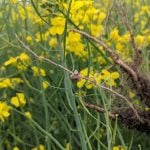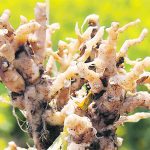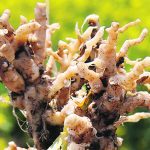Variety resistance is getting more specific on crop disease pathogens, but that information must be conveyed in a way that actually helps producers make rotation decisions.
Tag Archives clubroot

Going beyond “Resistant” on crop seed labels
Variety resistance is getting more specific on crop disease pathogens, but that information must be conveyed in a way that actually helps producers make rotation decisions.

Canola clubroot resistance: what new seed labels mean for growers
Proposed label changes could give growers detailed info to rotate varieties and preserve resistance in canola crops
Improved seed labelling can help canola growers make better variety choices, reduce disease pressure and protect the long-term effectiveness of clubroot resistance.

Vigilance urged as clubroot soars
With patchy wet conditions throughout the province, clubroot came out in force in Alberta in 2024. Its favourite targets were in a pocket of municipalities around Edmonton. These “hot spots” included the counties of Leduc, Parkland, Sturgeon, Strathcona and Camrose — all areas with a consistent history of clubroot. However, the canola disease was found […] Read more

Clubroot fights back with increased pathotypes
WINNIPEG — There are now 55 different types of clubroot across the Prairies. About a decade ago, in 2016, the number of pathotypes was 17. The increasing number of variants of the soil-borne disease is a concern, but canola growers need to remember that most of these pathotypes are rare, said Steve Strelkov, a plant […] Read more
Look back at Aug. 1, 2019, issue
This column is part of a series that marks the Western Producer’s 100th anniversary by taking a deep dive every week into a past issue of the paper. The front page of the Aug. 1, 2019, issue was a good news-bad news scenario. The good news was in a story about Alberta Agriculture researchers training […] Read more

Clubroot removed from official declared pest list in Sask.
Richardson’s ground squirrel, grasshoppers and the warble fly are also no longer on the province’s list of declared pests
REGINA — Clubroot is among several pests the Saskatchewan government has now deregulated. The government in June repealed the Pest Control Act and replaced it with the Plant Health Act and its accompanying regulations. As a result, clubroot, Richardson’s ground squirrel, grasshoppers and the warble fly are no longer on the list of declared pests. […] Read more
Sask. may deregulate pests
REGINA — The Saskatchewan agriculture ministry is reviewing several pests for possible deregulation, including clubroot, grasshoppers and Richardson’s ground squirrels. Changes could be in place by spring 2024. SaskCanola requested changes a year ago to how clubroot is treated. The organization asked for clubroot to be removed from the Pest Control Act where it had […] Read more

Disease roundup: Verticillium has breakout year
Plant pathologists are still sorting through the data, but 2023 may become the year that verticillium stripe emerged a major problem for canola growers in Western Canada. In 2022, Saskatchewan Agriculture staff discovered verticillium is a common disease in the eastern part of the province. In the fall of 2023, producers in other parts of […] Read more

New clubroot strains found in Alta.
New clubroot strains capable of infecting canola plants that have been bred to resist the disease have been found in fields across the Prairies, said a researcher at the University of Alberta. Twenty-five unique clubroot pathotypes were found in samples taken in 2019 and 2020 from more than 250 fields in Alberta, Manitoba and Saskatchewan, […] Read more

Clubroot research receives funding boost in Alta.
Scientists hope to identify naturally occurring genes that boost resistance and then breed that resistance into new canola varieties
Researchers at the University of Alberta have received $1.25 million to look for new ways to help farmers fight clubroot, a disease threatening Canada’s multibillion-dollar canola sector. As part of a five-year research project, scientists hope to identify naturally occurring genes that boost resistance to clubroot, as well as breed such resistance into new canola […] Read more


